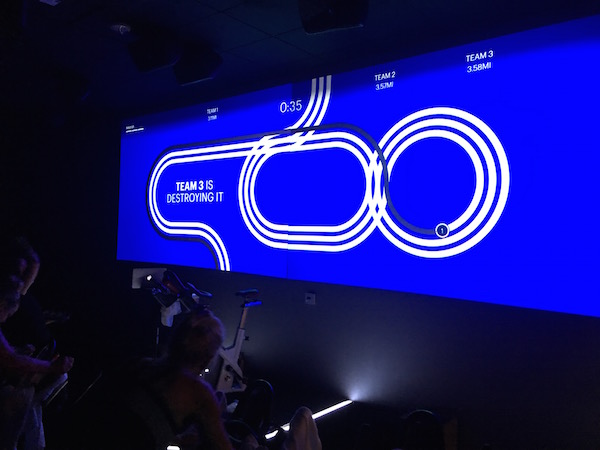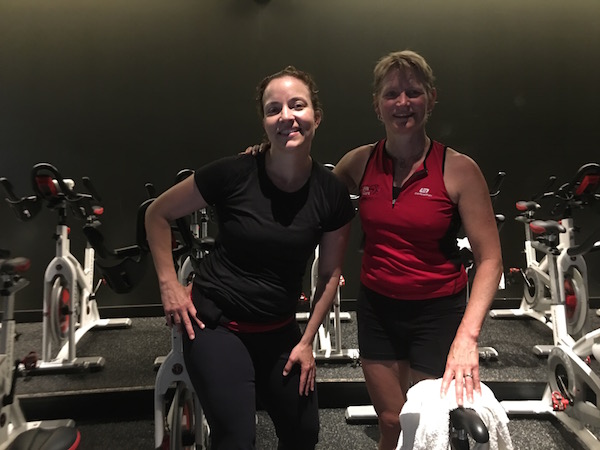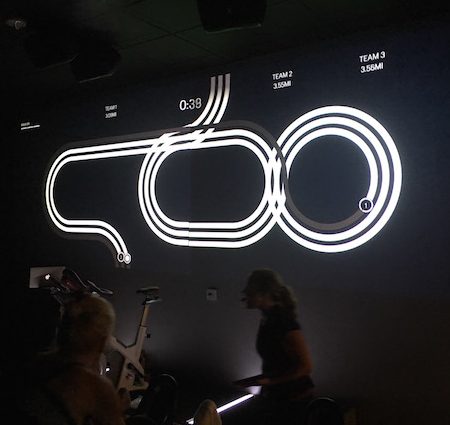Last April while in New York City I had the opportunity to go to an Equinox Pursuit class taught by Schwinn master trainer Rachel Buschert Vaziralli. I wrote about my experience in this post. It was one of their signature classes called Burn, and while I really enjoyed the class, it was such a high-intensity workout I know it’s something I couldn’t do that often. Rachel told me to come back and take their other signature class called Build. She knew it would be more up my alley since they were longer intervals of 7–10 minutes.
Well, I didn’t have to go back to New York to experience it. I was in San Diego visiting family a few weeks ago and got to go take a class at the Equinox in La Costa with instructor Monica McCall.
Rachel was right! Build is incredible and for me, it’s more of what I think a fantastic indoor cycling workout should include. I think I’m probably in the minority, based on my discussion with Rachel, Monica, and Jeffrey Scott, the creator of the Pursuit program for Equinox. All of them told me that most people prefer Burn since they like the shorter HIT training. It could also have something to do with people’s lack of ability to focus for more than 3 minutes at a time.
The idea behind the Build Pursuit class is that it is a more “endurance” type of class, focused on four intervals of 7 to 10 minutes in length. If you are pushing at a sustained intensity of “hard” for that length of time, you have to be predominantly aerobic. But that doesn’t mean it’s easy by any stretch. It’s very challenging and due to the competitive nature of the class, the effort is more likely to be right around lactate threshold, and occasionally just above.
Similar to the Burn class I took in New York, the “games” that appear on the screen are a crucial part of the motivation. You are represented on the screen as a circle; the harder you go, the more vivid the circle is, and you can see it moving with your extra output. Depending on the game, the room is divided into two or three teams, and you can see exactly where you are performing based on the amount of power you are putting out on the bike, represented by miles on the screen.
My favorite game was a three-way competition. Your team is represented by a small circle that winds around the screen like on a race track. As your team moves forward, the track behind it turns white. You can see in the image below, team 1 is quite a bit behind. The screen announced that team 3 was “destroying it.” My team 2 was not far behind team 3.

Monica did a great job motivating the room. She was superb at explaining the upcoming efforts, reminding everyone that this was not like the high-intensity Burn where you put out a ton of effort over a short amount of time, but rather you needed to carefully dole out your effort over the 7 or 10 minutes.
Monica stressed the importance of the recovery interval, making sure everyone knew that they could not give the effort required during the work interval if they didn’t take their recovery seriously. She walked around the room and reminded everyone to drink, and even offered to get them more water, or a towel, or help them with their console if needed. She was the quintessential coach who knew her job was to make sure everyone in the room had the best experience possible!
She was off the bike more than on it, something I always find impressive. Since the room was pretty dark and backlit by the screens, even those who say they prefer to see their instructor on the bike wouldn’t have noticed the difference. (You can see her in the image at the top of the page.)
She used a combination of climbing and faster flat road efforts for the work intervals, and there were plenty of opportunities to get out of the saddle. However, I was glad when she started one of the climbing intervals with a long seated effort of about 5 minutes. Looking around the room, I expected to see people standing anyway, but I was impressed that most of them didn’t. That’s the sign they are well trained to appreciate the greater amount of work that is done seated!
The only thing I would have liked to have seen was a little more focus on cadence. She used the music to drive the cadence, but she didn’t often give cadence ranges by number. With the Schwinn computers, that would have been easy. At the end of one of the intervals, she asked for a surge in effort by “doubling the leg speed.” Since I was climbing at 75 rpm at the time (on the beat), that would not have been humanly possible with good form or with any resistance to push to 150 rpm. I really don’t think she meant it literally. Asking for an additional 10 or 20 rpm to the same resistance would have been sufficient to squeeze out more watts and bring everyone to breathless at the end of the interval.
Oh, and her music? Awesome! A combination of popular, electronic, and remixed songs gave the class plenty of variety. I even got this gem from her.

I loved how I felt after this workout! I was wiped out but not wrecked and my face glowed for hours afterward (you can even see that my face matches my jersey in the photo above)! If you are ever in the Carlsbad area north of San Diego, don’t miss a ride at Equinox with Monica. Her husband Pete McCall also teaches there. If you have been in the fitness industry for some time, you will recognize Pete’s name as an internationally renowned fitness presenter and trainer.
In fact, if you have a chance to get to any Equinox anywhere, I highly recommend the Pursuit, especially the Build class. I would love to know if you felt the same way about it!
This type of threshold workout is one that is so beneficial for improving aerobic conditioning, raising lactate threshold, improving functional threshold power, and burning a greater amount of calories. We teach the importance of threshold workouts at the Indoor Cycling Association. In fact, we have a template with over 50 different profiles all based on longer intervals at lactate threshold (ICA members can find it here).
Have you been to a Pursuit class? What did you think?

